2-year COVID pause brings public transport change, but new normal looks old

FILE PHOTO: The Metropolitan Manila Development Authority is reimposing the number coding scheme in Metro Manila this week to lessen the volume of vehicles on Edsa, the capital’s main thoroughfare, and other major roads in the metropolis. NIÑO JESUS ORBETA / PHILIPPINE DAILY INQUIRER
(First of two parts)
MANILA, Philippines—When COVID-19 hit, one of the challenges was how to implement social distancing inside public utility vehicles (PUVs) and restore people’s confidence in the safety of their rides.
It was only late last year when the government raised the passenger capacity of PUVs to 70 percent, which is 40 percent higher than 30 percent in 2020 at the height of the COVID pandemic.
As Filipinos, especially in Metro Manila, highly rely on public or active transportation, raising the capacity of PUVs was significant. As Transportation Secretary Arthur Tugade said, it will ease waiting lines.
Last March 1, the government eased restrictions in Metro Manila and 38 areas. With Alert Level 1, the capacity of public or active transportation reverted to 100 percent.
Article continues after this advertisementWith the eased restrictions, 26-year-old Joshua Llego told the INQUIRER on March 1 that “there is this added aggravation of being exhausted apart from the fear of being infected.”
Article continues after this advertisementFor Robert Siy Jr., one of the convenors of the Move As One Coalition, the COVID-19 crisis highlighted the basic problems of public transportation in the Philippines:
- The fragility in public transportation services
- The long neglect of walking and cycling even though these are the most popular and sustainable travel choices
- The inefficient and unequal use of roads, which are currently devoted largely to private cars
Two years since the COVID-19 crisis hit, were these problems solved? INQUIRER.net will take a closer look to see if problems were solved to make public transportation better and why this is essential for Filipinos.
READ: Sensible public transport: A post-pandemic dream
The Filipino, day by day
AltMobility PH said that as the Japan International Cooperation Agency (Jica) and the Department of Science and Technology (DOST) revealed, 88 percent of Metro Manila residents rely on public or active transportation.
Dr. Cresencio Montalbo Jr. said in his paper “Public Transport Rationalization As A Means To Sustainability” that every day, 8.96 million people ride the iconic jeepneys in the Philippines while 1.87 million ride buses.
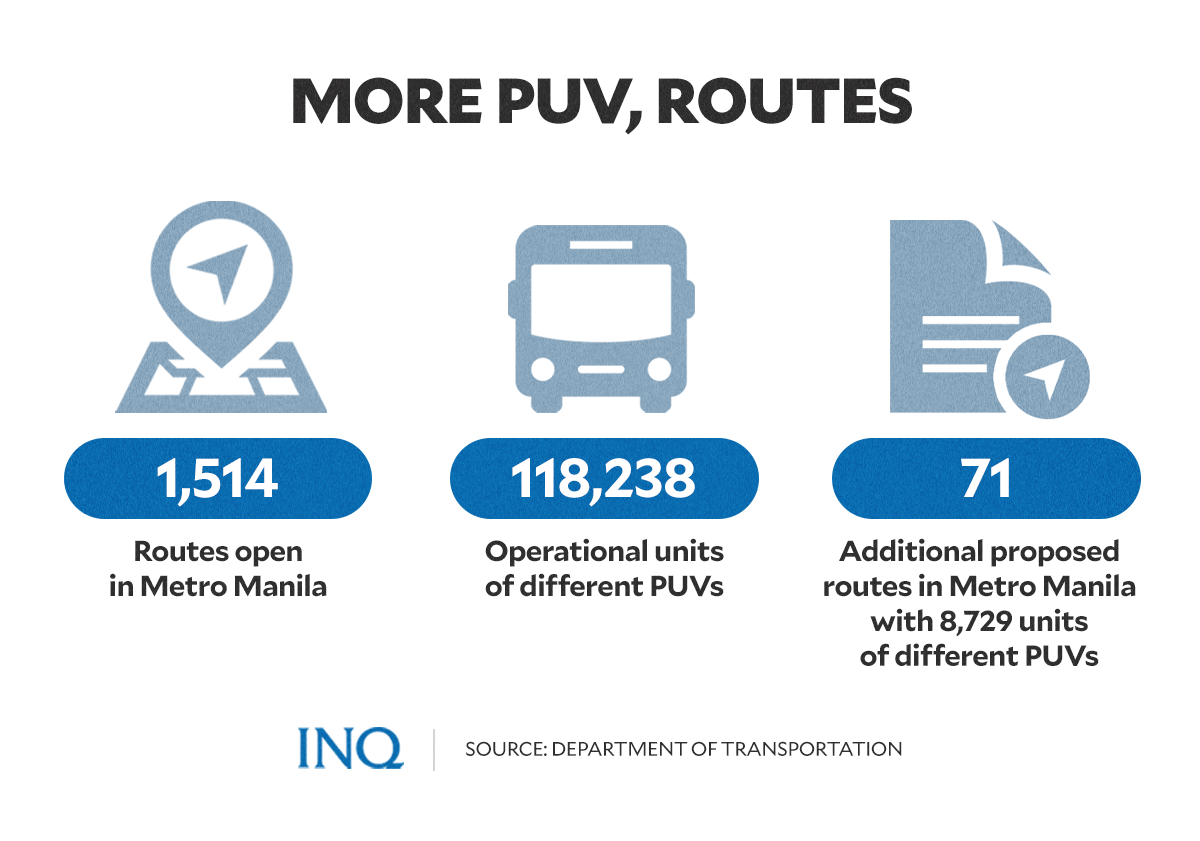
GRAPHIC: Ed Lustan
However, Move As One Coalition said the road space for people who rely on PUVs is only 22 percent––the rest is already for people with private vehicles.
This, as the 2022 General Appropriations Act (GAA) had a special provision which said that the “required” road space for pedestrians and individuals relying on public or active transportation was 50 percent.
The Social Weather Stations said last year that five percent of households own a 4-wheeled vehicle; 20 percent of households own a bike; and 36 percent of households own a motorcycle.
RELATED STORY: 87% of Filipinos want gov’t priority on public transport, bikes over private vehicles
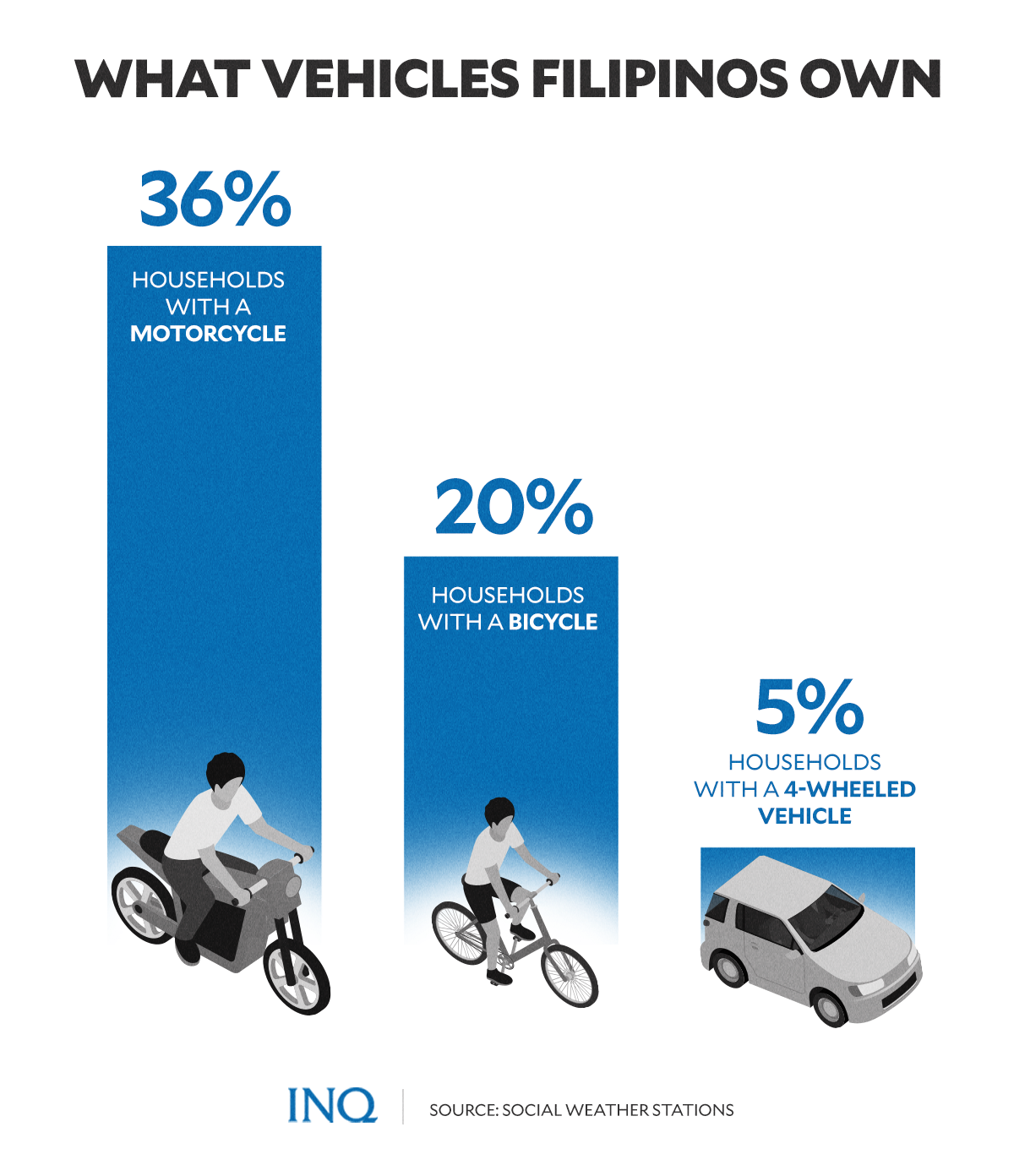
GRAPHIC: Ed Lustan
The Move As One Coalition stressed that over the years, “our roads and our public resources have been prioritizing cars over people,” saying that “average vehicle trips became longer.”
It said this indicated that over the past years, public transportation trips in Metro Manila’s main roads have collapsed—the reason that most non-home-based workers said it was harder to get to work.
Made better?
Siy told INQUIRER.net that, to the government’s credit, it has recognized problems with the “old normal” and initiated progressive reforms while the Philippines was on lockdown because of the COVID-19 crisis:
- Implementing protected bike lanes on main roads in order to attract more people to consider riding bikes
Last year, the Department of Transportation (DOTr) said Metro Manila has over 313 kilometers of bike lanes, complete safety features to encourage biking and keep cyclists safe.
- Placing PUVs on dedicated lanes, like the EDSA Busway, so that high capacity vehicles can have faster travel time and more “round trips”
In 2020 the DOTr, Land Transportation Franchising and Regulatory Board, and the Metropolitan Manila Development Authority started the initial operations of the EDSA Busway.
On Nov. 22, 2021, as the DOTr opened the EDSA Busway Buendia Station, it said the EDSA Busway already has 13 “operational” bus stations.
- Introducing service contracting as a way of placing public transportation on a more stable and sustainable basis.
The Service Contracting Program, which was proposed by the Move As One Coalition in 2020 to help drivers and people who rely on public transportation, was given P7 billion in government funding.
READ: New strategies urged to improve public transport
Tugade said on Feb. 28 that this will pave the way for the continuous operation of the Libreng Sakay program and will provide more incentives for drivers and operators.
He likewise said that there are currently 1,514 open routes and 118,238 PUVs in Metro Manila. The DOTr said then that by March 15, there will be more––71 routes and 8,729 PUVs.
Presently, a bus can carry a minimum of 25 passengers, a UV Express has a capacity of 10 to 16 passengers, while a jeepney can carry 11 to 20 passengers.
Tugade said the rehabilitation of MRT-3 will likewise lead to having more operational trains (from six to 22), faster operating speed (from 25 to 60 kph), and reduced train intervals (from 9 to 3.5 minutes).
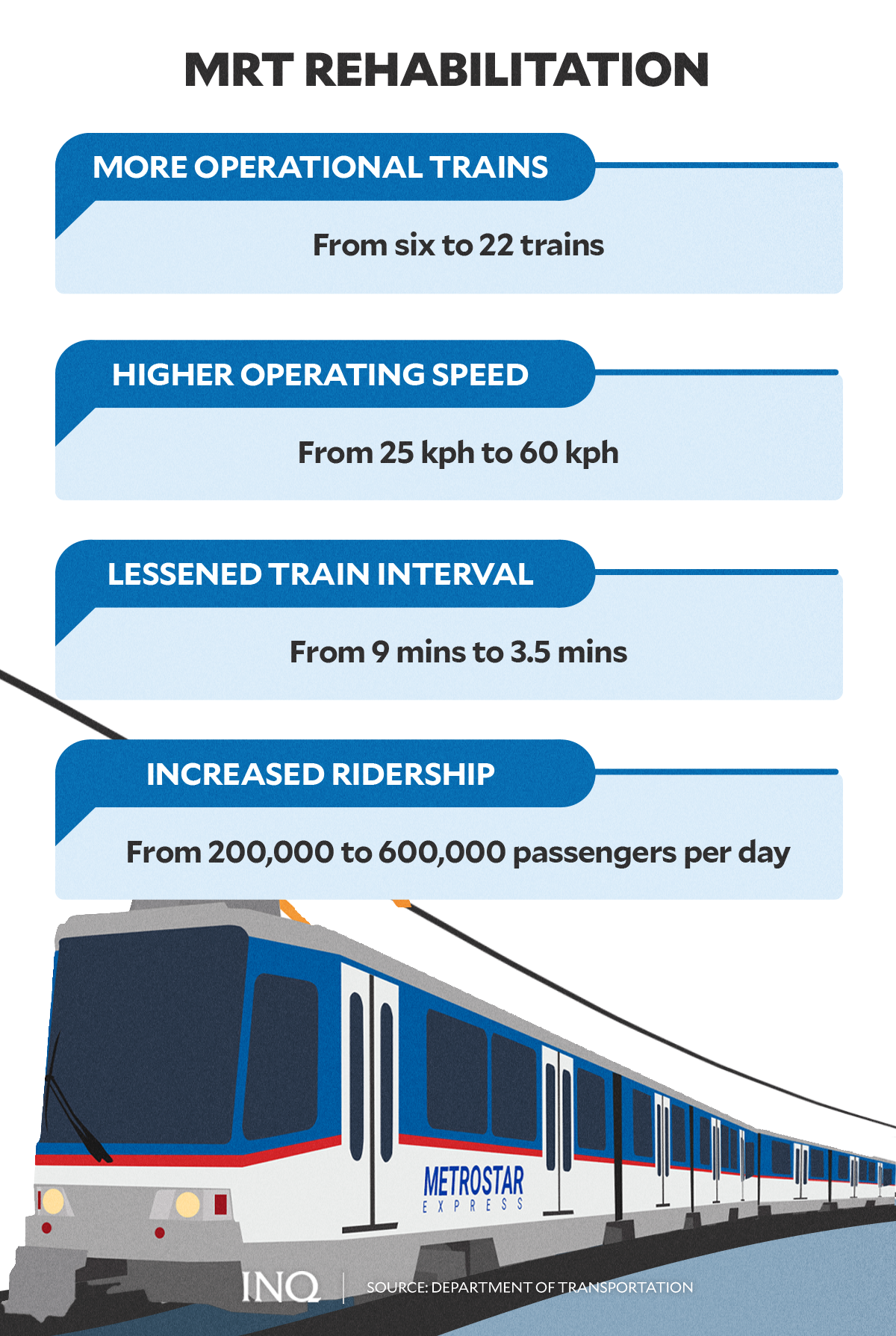
GRAPHIC: Ed Lustan
The MRT-3 Rehabilitation Project, which Tugade said is already completed, will likewise increase ridership––from 200,000 to 600,000 passengers.
The DOTr said last year that one LRT-1 train set can carry an average of 1,122 to 1,388 passengers, LRT can carry 1,628 passengers, MRT-3 can carry 1,182 passengers, while PNR can carry 953.
Not yet enough
While Siy said that these were “good initiatives,” there was a lot more that was needed today, stressing that “these reforms need to be expanded in a major way, institutionalized and made permanent.”
Montalbo said there’s a need to develop an “integrated public transport system” that would enable the efficient movement of people in Metro Manila through an “ecologically sustainable travel” that was cost effective.
He then proposed “16 mass transit trunk-feeder routes linking areas of highest demand, creating [a] network of transit routes [and] strong interchange between routes.”
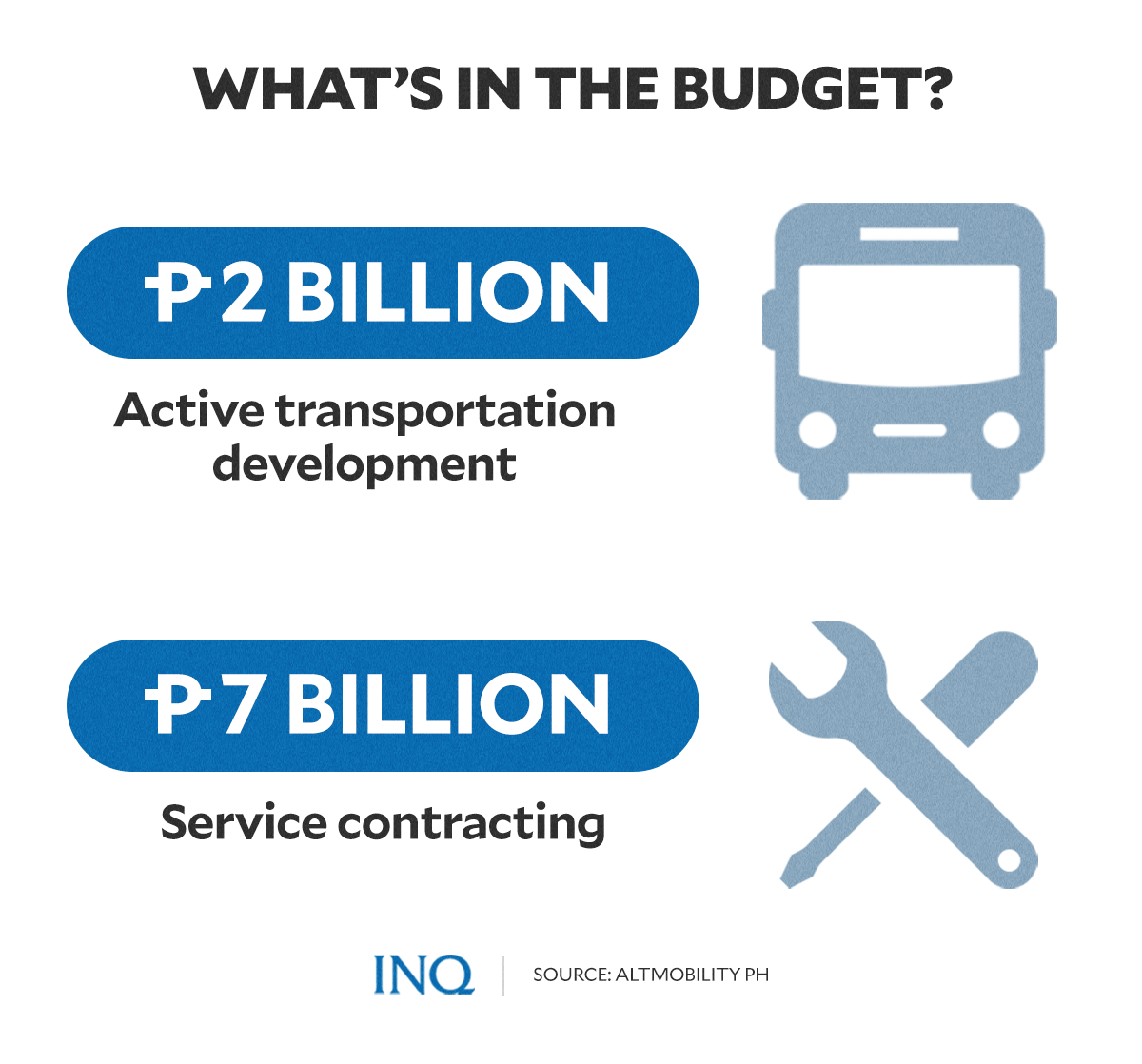
GRAPHIC: Ed Lustan
From 2010 to 2021, 99 percent of P2.8 trillion in “road-based infrastructure budget” went to road construction, widening and maintenance. Only one percent, or P40 billion went to road-based public transportation.
Siy explained that the special provisions of the 2022 GAA, which likewise gave P2 billion for Active Transportation Development, will enable the government to expand these initiatives, especially now that a crisis on oil has hit.
“The clear message in the 2022 budget law is that roads are for all Filipinos, not only for Filipinos who are in cars. Adopting this principle will improve the mobility environment for all of us,” he said.
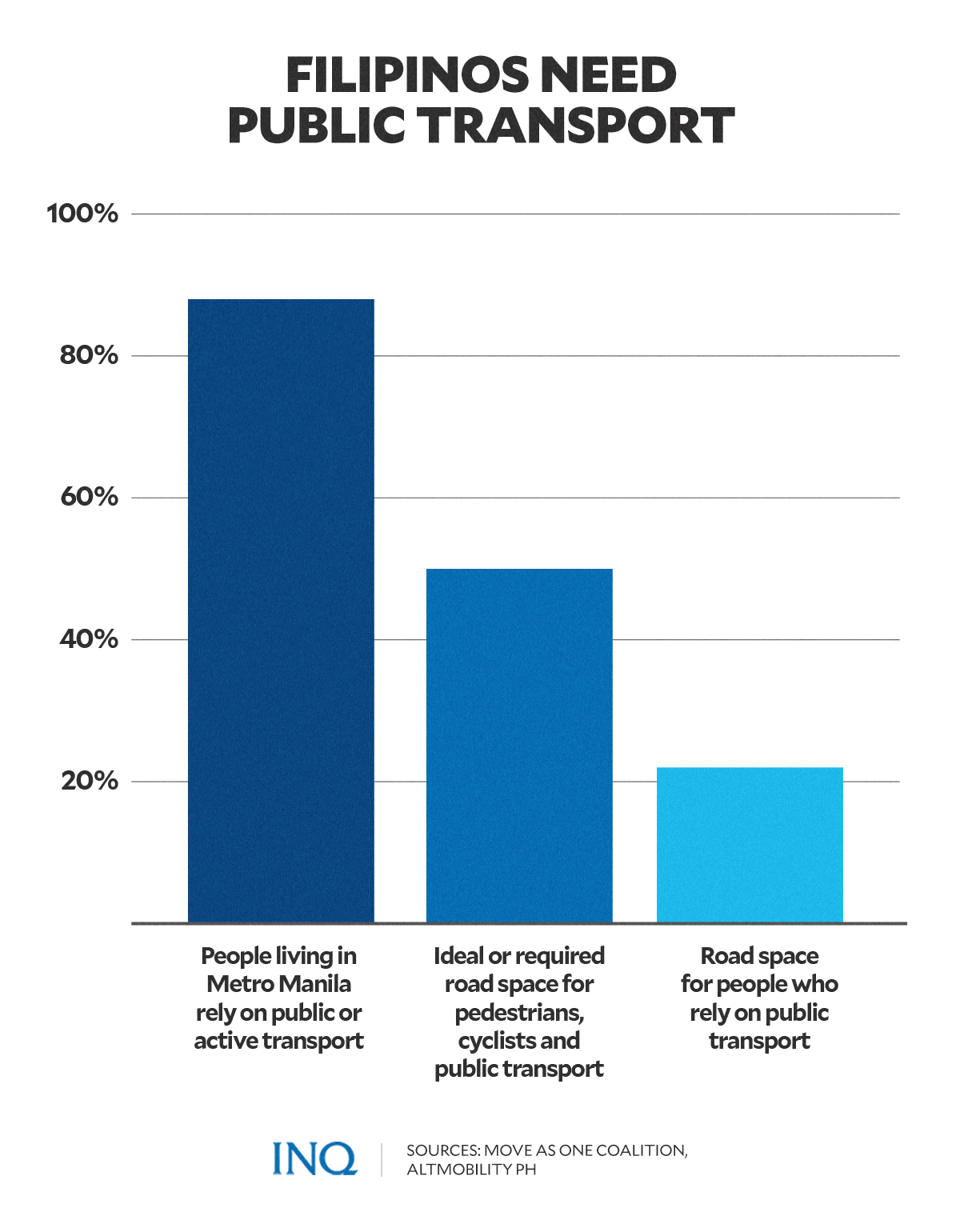
GRAPHIC: Ed Lustan
Siy stressed that the provisions in the budget law call for giving 50% of road space for public transportation, pedestrians and bicycles, and require the Department of Public Works and Highways to introduce bike lanes on all roads and bridges.
Last year, the House of Representatives was asked to pass the Magna Carta of Commuters since “the protection of commuters should be considered as a legislative priority.”
AltMobility PH said this will pave the way for making public transportation available within 500 meters and public services connected to the other within a range of 300 meters.
With this, the waiting time in terminals will not exceed 10 minutes in peak hours and that a PUV will be able to traverse 15 kilometers within one hour.
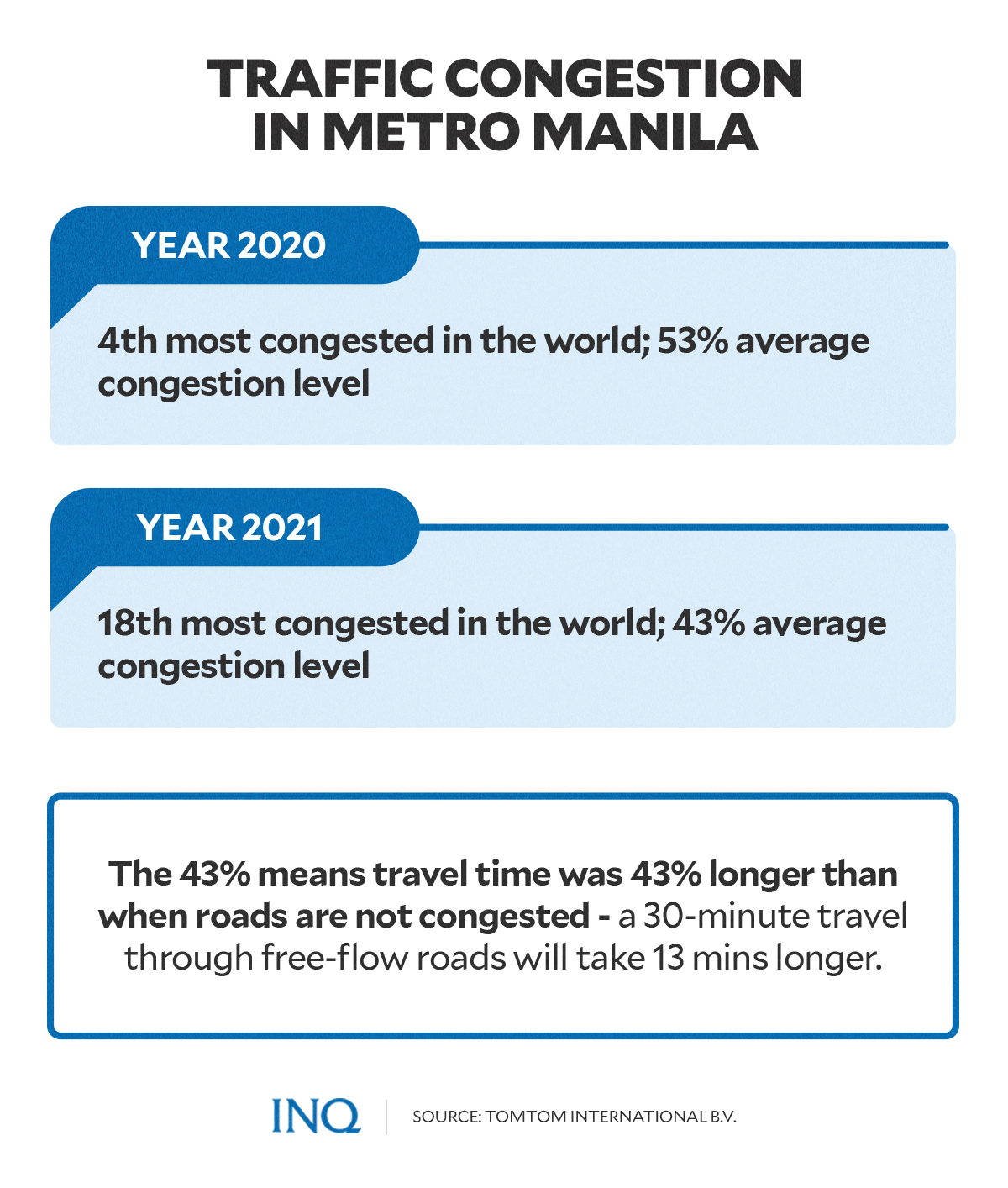
GRAPHIC: Ed Lustan
The TomTom International B.V. said Metro Manila was the 18th most congested city in the world with 43 percent average congestion level, down from the 53 percent in 2020, the year when the COVID-19 crisis hit.
The 43% means travel time was 43% longer than when roads are not congested––a 30-minute travel through free-flow roads will take 13 minutes longer.

GRAPHIC: Ed Lustan
Statista, a data consumer company, said 18 percent of Filipinos said in 2021 that their travel takes less than 15 minutes; 15 to 29 minutes (28 percent); 60 to 119 minutes (eight percent); over 120 minutes (five percent); while 12 percent are not commuting.
RELATED STORY: As COVID threat still exists, PH recovery hangs in the balance
TSB
For more news about the novel coronavirus click here.
What you need to know about Coronavirus.
For more information on COVID-19, call the DOH Hotline: (02) 86517800 local 1149/1150.
The Inquirer Foundation supports our healthcare frontliners and is still accepting cash donations to be deposited at Banco de Oro (BDO) current account #007960018860 or donate through PayMaya using this link.